November 2025 marks a pivotal moment in the global technology landscape, with artificial intelligence, cybersecurity innovations, and quantum computing breakthroughs dominating headlines worldwide. As businesses and consumers navigate an increasingly digital world, understanding these transformative trends has become essential for staying competitive and informed. This comprehensive analysis explores the most significant technological developments shaping our present and future, offering insights into how these innovations are revolutionizing industries from healthcare to manufacturing, and what they mean for society at large.thoughtworks+2quytech
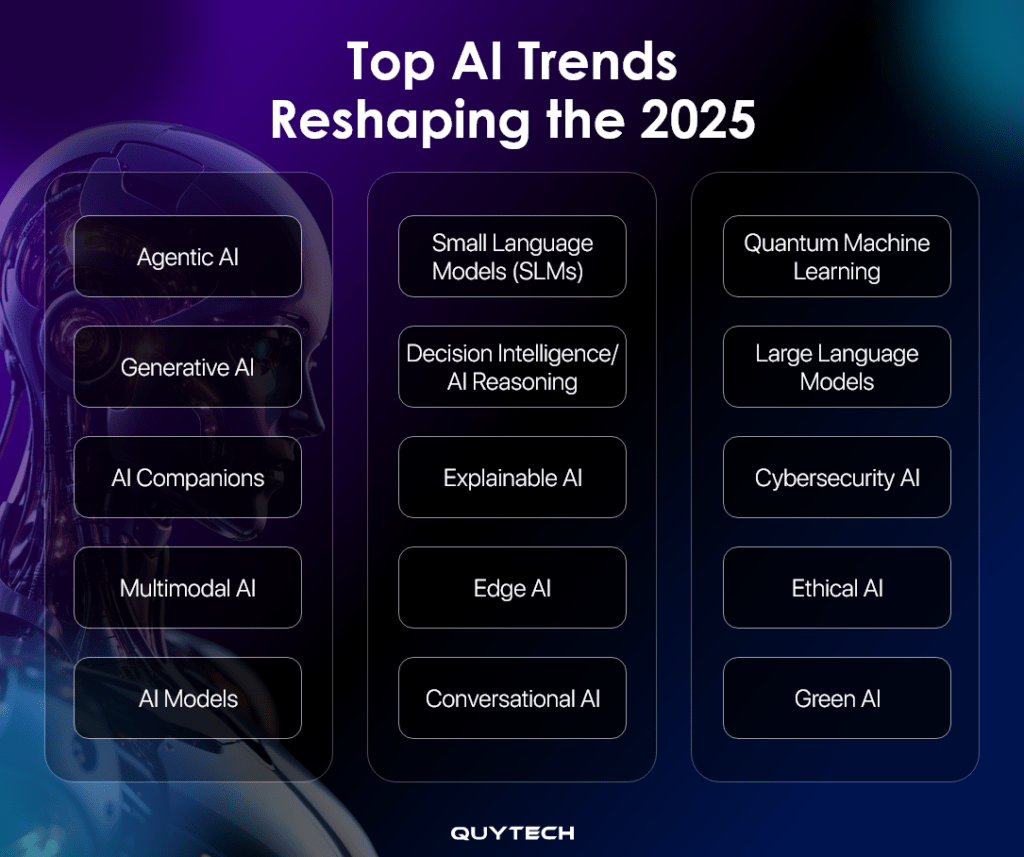
Top AI trends expected to shape the future of artificial intelligence in 2025 quytech
Artificial Intelligence: The Dominant Force Reshaping Industries
Agentic AI and Context Engineering Revolution
The artificial intelligence sector has witnessed unprecedented growth in November 2025, with agentic AI emerging as one of the most transformative developments in recent months. Unlike traditional chatbots that simply respond to queries, agentic AI systems can autonomously perform complex tasks, make decisions, and execute multi-step workflows without constant human intervention. According to recent surveys, 33% of Indians are already using agentic AI, with another 44% planning to adopt this technology soon, demonstrating the rapid acceptance of these advanced systems.thoughtworks+2
Context engineering has risen to prominence as a critical practice in AI development, referring to the careful preparation and structuring of background information fed to AI models to ensure reliable task performance. The Model Context Protocol (MCP), originally published by Anthropic in late 2024, has become ubiquitous in less than a year, with thousands of MCP servers now providing bridges to everything from GitHub repositories to enterprise SAP systems. This standardized approach enables AI developers to integrate new tools and data sources much faster while maintaining vendor neutrality, accelerating the pace of innovation across the industry.thoughtworks
Infrastructure Demands and GPU Orchestration
The explosive growth of AI workloads has created unprecedented infrastructure demands, particularly for GPU clusters required to train large language models and run inference for AI features. Platform engineering teams are now managing complex multi-stage pipelines and continuously tuning for throughput and latency to keep AI workloads operational. The challenge is compounded by cost considerations, as GPU cloud instances are expensive and billed regardless of utilization, forcing organizations to adopt smarter orchestration strategies to maximize value.thoughtworks
Kubernetes, originally designed for stateless web applications, has proven remarkably adaptable for AI workloads, especially when coupled with additional libraries such as Kueue. Recent Kubernetes releases have introduced enhancements like Dynamic Resource Allocation for GPUs and improved hardware topology awareness, enabling more efficient resource management. Tools like NVIDIA DCGM Exporter have become essential for monitoring distributed GPU systems, helping teams optimize their expensive infrastructure investments.thoughtworks
Multi-Modal AI and Generative Technologies
Multi-modal AI systems that process multiple data types simultaneously—including speech, images, video, audio, text, and numerical datasets—are creating more holistic and human-like cognitive experiences. Google DeepMind’s Gato represents a breakthrough in this space, performing language, visual, and robotic movement tasks within a single system. Meta has also introduced five significant new AI models and research initiatives, including multi-modal systems capable of processing both text and images, advanced language models, and music generation technology.appinventiv
Generative AI continues to dominate conversations about artificial intelligence trends in business environments. The global conversational AI market, valued at $11.58 billion in 2024, is projected to reach $41.39 billion by 2030, reflecting the technology’s rapid adoption across industries. Companies are leveraging conversational AI not just for customer service automation, but for complex, context-aware interactions that understand intent, tone, and emotion, significantly enhancing customer experience and productivity.appinventivmindsdb
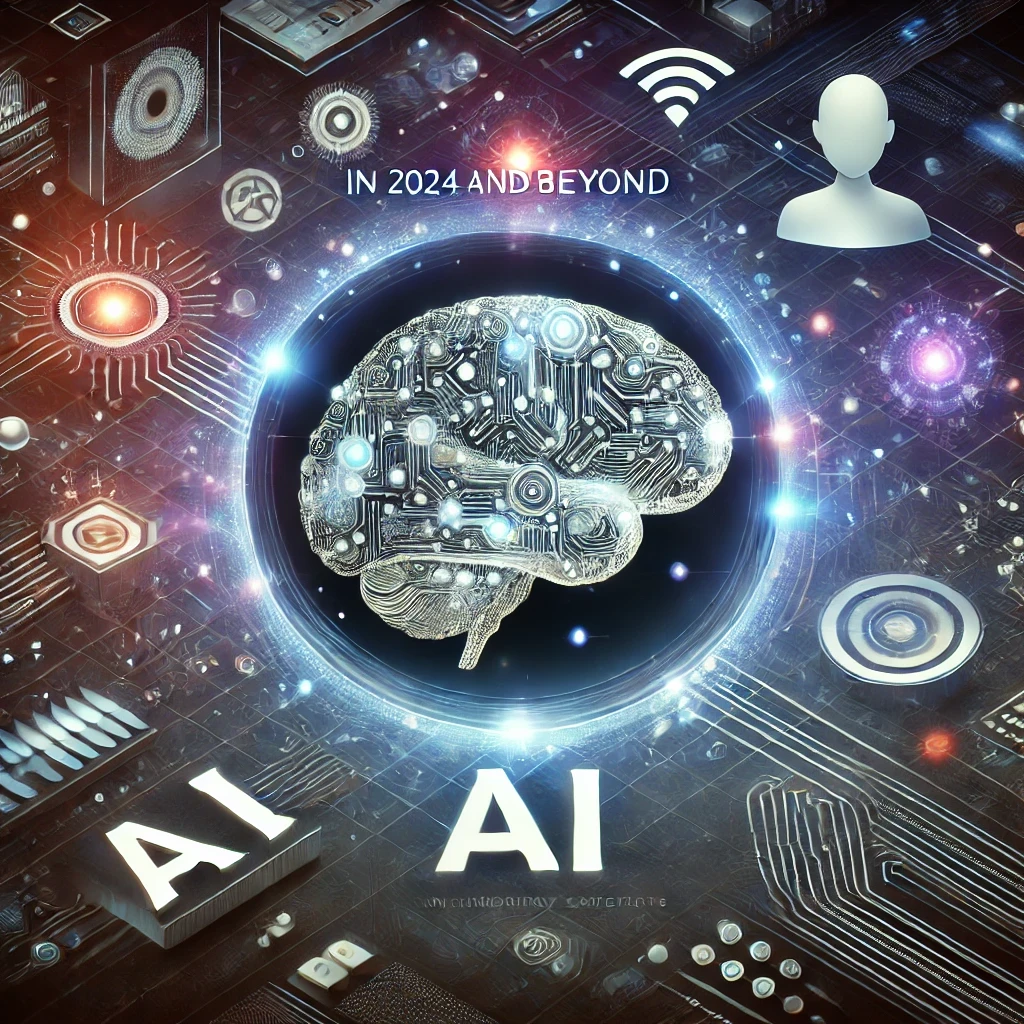
Futuristic depiction of AI and brain-computer interface technology mindsdb
Predictive Analytics and Business Intelligence
Predictive analytics has emerged as a cornerstone technology for businesses seeking data-driven decision-making capabilities. In manufacturing, predictive analytics enables companies to anticipate unexpected machine failures and prevent costly breakdowns before they occur. Retail organizations are using these technologies to optimize inventory management, improve delivery times, reduce operational costs, and ultimately increase sales and revenue.appinventiv
The adoption rate speaks volumes about predictive analytics’ value proposition: 78% of organizations now use AI in at least one business function, demonstrating the technology’s growing dominance across sectors. This widespread implementation reflects AI’s proven ability to help businesses make smarter, faster decisions based on comprehensive data analysis rather than intuition alone.appinventiv
Quantum AI: The Next Frontier
Quantum AI represents one of the most exciting developments on the technological horizon, combining quantum computing principles with artificial intelligence algorithms to solve complex problems far more quickly than traditional computers. This emerging field promises breakthroughs in areas like complex system optimization, material science, and data encryption by handling large datasets more effectively and performing computations currently impractical with conventional processing power.appinventiv
The tremendous processing capacity and accuracy that quantum AI promises could fundamentally transform industries previously restricted by traditional computing limitations. As this technology matures, it is expected to drive innovation in fields ranging from drug discovery to climate modeling, opening possibilities that were previously the realm of science fiction.appinventiv
Cybersecurity: Defending Against Evolving Threats

Digital security concepts illustrated with a headset and tablet hitachi-sunway-is
Ransomware and Advanced Persistent Threats
The cybersecurity landscape in November 2025 has been marked by sophisticated attacks and the continued evolution of threat actor tactics. Recent incidents have highlighted the vulnerability of even well-protected systems, with ransomware groups like Akira claiming theft of 23GB of data from Apache OpenOffice systems. The U.S. Cybersecurity and Infrastructure Security Agency (CISA) has issued urgent alerts about critical vulnerabilities being actively exploited to deploy ransomware, including a use-after-free vulnerability in the Linux kernel.cybersecuritynews
Hackers have been exploiting Cisco IOS XE vulnerabilities to deploy persistent web shells known as BADCANDY, targeting unpatched devices across Australia and other regions. These attacks demonstrate the importance of timely security updates and comprehensive vulnerability management programs. The Gunra ransomware, which emerged in April 2025, has established itself as a significant dual-platform threat targeting both Windows and Linux systems, forcing organizations to adopt multi-layered defense strategies.cyberpress+1
AI-Powered Security and Threats
Artificial intelligence is playing a dual role in cybersecurity, both as a defensive tool and as a weapon for attackers. Google has released reports describing novel ways malware is using AI to adapt and evade detection, highlighting the arms race between security professionals and cybercriminals. Microsoft’s red-teaming security group discovered a zero-day vulnerability that allows malicious actors to design harmful proteins with AI, demonstrating the potential dark side of these powerful technologies.securityweek+1
On the defensive front, AI-powered security systems are enabling faster threat detection and response. Organizations are implementing AI-driven solutions for identity threat detection, anomaly identification, and automated incident response. The technology’s ability to analyze vast amounts of data in real-time and identify patterns that human analysts might miss makes it an invaluable tool in modern cybersecurity operations.securityweekfortinet
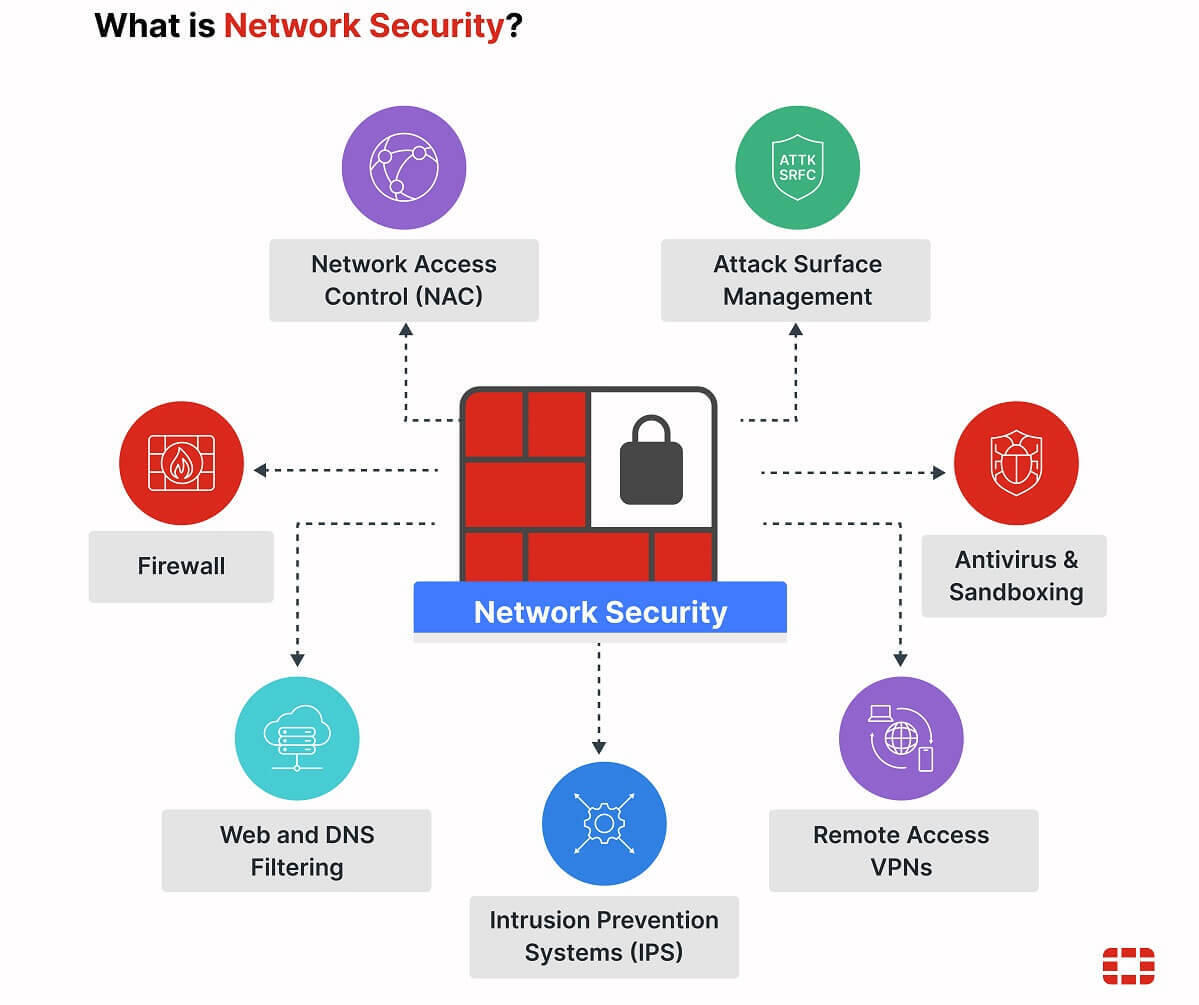
Key components and types of network security visualized in an infographic fortinet
Infrastructure and Cloud Security
Cloud infrastructure security remains a critical concern as more organizations migrate their operations to public cloud platforms. Amazon Web Services experienced significant operational challenges in its US-EAST-1 region in late October 2025, with elevated latencies affecting EC2 instance launches and cascading impacts on dependent services. Such incidents underscore the importance of multi-region deployment strategies and robust disaster recovery planning.cybersecuritynews
The theft of firewall configuration files from all SonicWall customers using the cloud backup service highlights the risks associated with centralized security management systems. Organizations are responding by implementing zero-trust architectures, enhancing access controls, and adopting identity exposure management capabilities to minimize their attack surface. Companies like Armis have surpassed $300 million in annual recurring revenue as they prepare for IPOs, reflecting strong market demand for comprehensive security solutions.securityweek
Supply Chain Security and Zero-Day Vulnerabilities
Supply chain attacks have become increasingly sophisticated, with the JavaScript ecosystem experiencing one of its most damaging incidents in September 2025 when the self-replicating worm “Shai-Hulud” infiltrated multiple extension marketplaces. The attack demonstrated how malicious code can spread rapidly through trusted developer tools and repositories, compromising countless downstream applications and systems.cybersecuritynews
Zero-day vulnerabilities have surged in 2025, with threat actors actively exploiting previously unknown flaws before patches become available. CISA’s Known Exploited Vulnerabilities catalog continues to grow, with recent additions including a Rapid7 Velociraptor vulnerability being used in ransomware campaigns. Organizations must maintain constant vigilance, implementing robust patch management processes and deploying advanced threat detection systems to identify exploitation attempts.cyberpress+1
Quantum Computing: From Theory to Practice
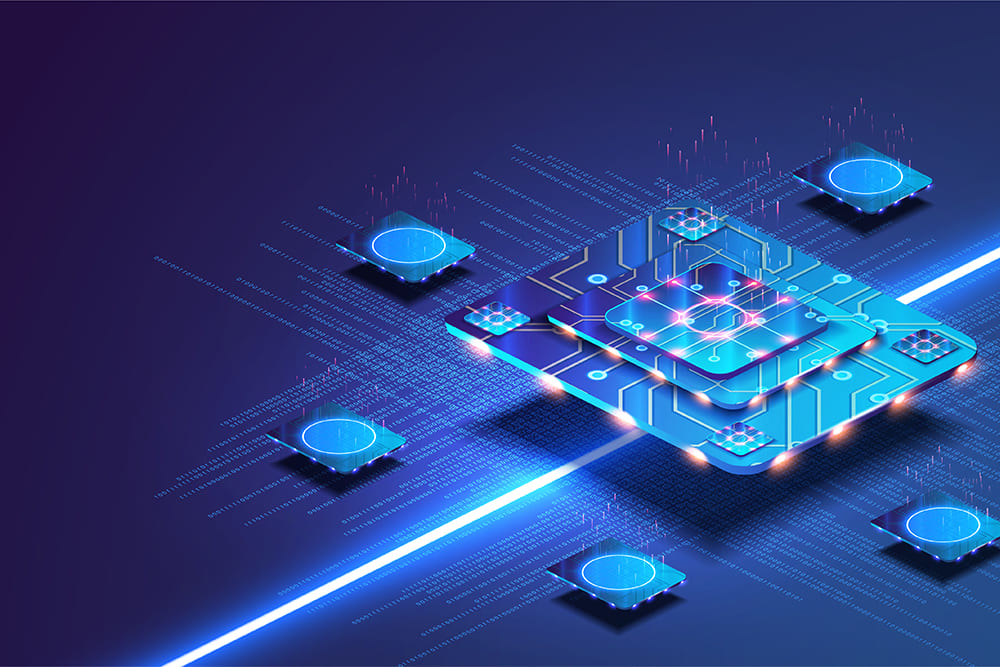
Futuristic representation of quantum computing technology with layered circuits and glowing quantum core bernardmarr
Hardware Advances and Accessibility
Quantum computing has transitioned from theoretical research to practical application in 2025, with major technology companies making significant hardware advances. NVIDIA’s introduction of the DGX Spark, a desktop AI supercomputer offering 1 petaflop performance on models with up to 200 billion parameters, demonstrates the democratization of powerful computing resources. Such systems, previously available only to large research institutions and corporations, are now becoming accessible to smaller organizations and individual researchers.oreilly
The integration of quantum computing principles with artificial intelligence is opening new frontiers in computational capability. Quantum AI systems can process information in fundamentally different ways than classical computers, potentially solving optimization problems, simulating molecular interactions, and breaking encryption schemes that would take conventional systems millennia to address. This convergence of quantum mechanics and machine learning represents one of the most promising technological developments for the coming decade.appinventivmarkovate
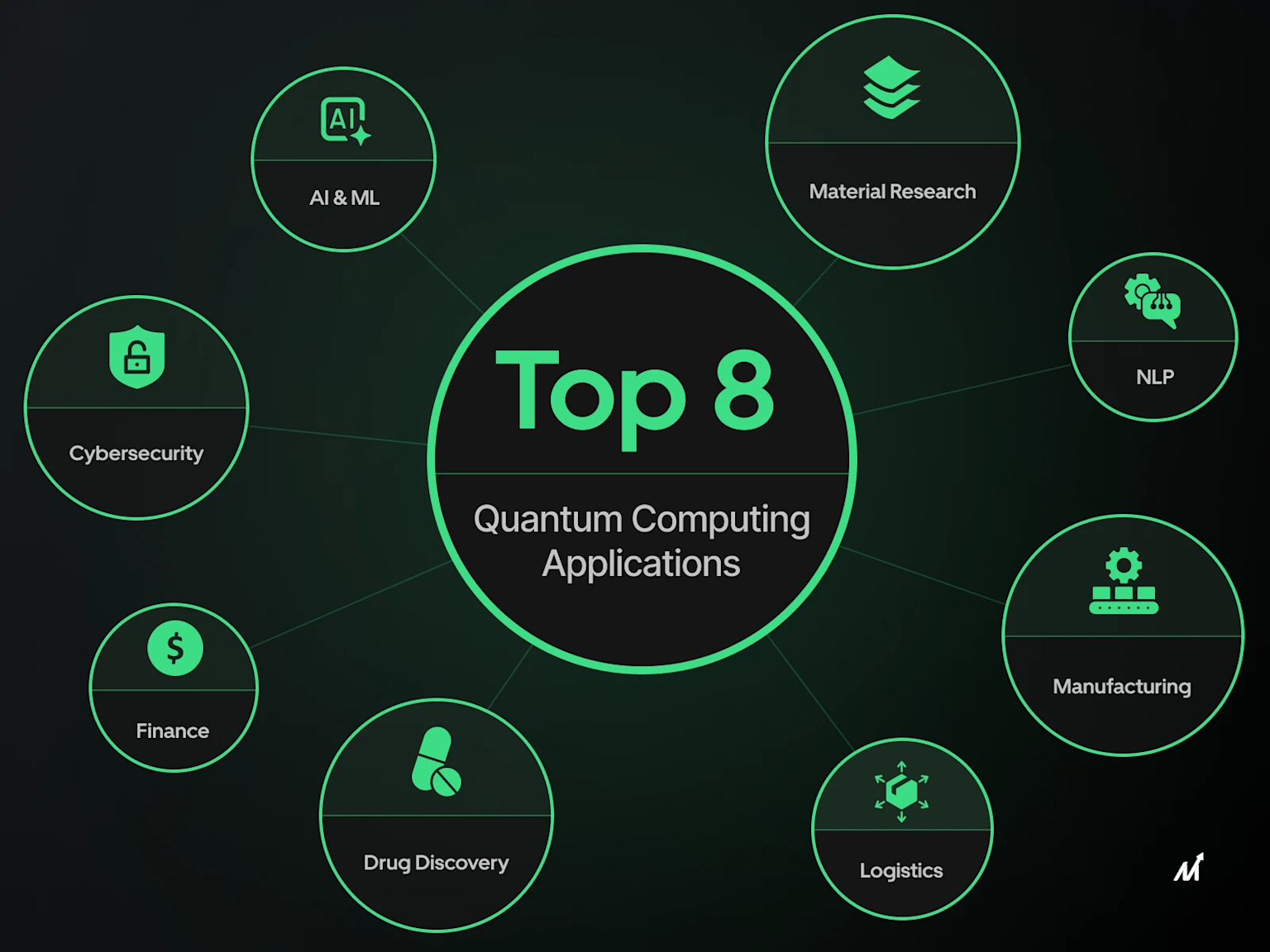
Top 8 quantum computing applications including AI & ML, material research, NLP, manufacturing, logistics, drug discovery, finance, and cybersecurity markovate
Applications Across Industries
Quantum computing applications are expanding rapidly across multiple sectors. In healthcare, scientists have discovered new narrow-spectrum antibiotics using AI to predict how these medications would work—apparently a first in pharmaceutical development. AI has also successfully designed DNA for a bacteriophage capable of infecting and killing E. coli bacteria, marking the first time artificial intelligence has been used to synthesize an entire genome.oreilly
The finance industry is exploring quantum computing for portfolio optimization, risk analysis, and fraud detection, leveraging the technology’s ability to process vast numbers of scenarios simultaneously. Manufacturing and logistics companies are using quantum algorithms to optimize supply chains, reduce transportation costs, and improve production efficiency. As quantum systems become more stable and accessible, their practical applications will continue to expand across virtually every industry.
India’s Emergence as a Technology Powerhouse
Government Initiatives and Investment
India has made remarkable strides in establishing itself as a global technology leader. Prime Minister Narendra Modi launched a ₹1 lakh crore Research, Development and Innovation scheme fund at the Emerging Science, Technology and Innovation Conclave (ESTIC) 2025, underscoring the government’s commitment to advancing scientific capabilities. The conclave brought together over 3,000 participants from academia, research institutions, industry, and government, along with Nobel Laureates, eminent scientists, innovators, and policymakers.pmindia+1
Under the India AI Mission, investments exceeding ₹10,000 crore are being made to ensure artificial intelligence benefits every section of society. The government emphasizes making technology ethical and inclusive, recognizing AI’s transformative power while addressing concerns about equitable access and responsible development. These initiatives position India as not just a technology consumer but a major contributor to global innovation.pmindia
Startup Ecosystem and Innovation
The second day of ESTIC 2025 featured PitchX, bringing together more than 20 pioneering DeepTech startups and leading investors, showcasing India’s burgeoning innovation ecosystem. The event highlighted advancements across 11 key thematic areas, including Advanced Materials & Manufacturing, Artificial Intelligence, Bio-Manufacturing, Blue Economy, Digital Communications, Electronics & Semiconductor Manufacturing, and Quantum Science & Technology.pmindia+1
Indian consumers are rapidly adopting AI technologies, with 73% already relying on AI to support shopping decisions compared to 61% across the Asia-Pacific region. Additionally, 66% prefer AI for product comparisons, demonstrating comfort with automated assistance in daily activities. This high adoption rate creates a fertile testing ground for new technologies and positions Indian companies at the forefront of AI-driven commerce and services.economictimes
The Road Ahead: Balancing Innovation and Responsibility
Ethical Considerations and Governance
As technology becomes increasingly integrated into every aspect of life, ethical considerations and governance frameworks are gaining prominence. Organizations are recognizing the importance of responsible AI development, implementing practices to ensure transparency, fairness, and accountability. The rise of explainable AI reflects growing demands for systems whose decision-making processes can be understood and audited by human stakeholders.thoughtworks+1
Regulatory bodies worldwide are developing frameworks to govern AI deployment, data privacy, and cybersecurity standards. The European Union continues to lead in establishing comprehensive technology regulations, while countries like India are crafting policies that balance innovation with consumer protection. This regulatory evolution is essential for building public trust and ensuring technologies serve societal interests rather than just commercial objectives.securityweek+1
Workforce Transformation and Skills Development
The technological transformation underway is reshaping workforce requirements across industries. While concerns persist about AI displacing jobs—estimates suggest 92 million jobs could be displaced by 2030—the technology is also expected to create 170 million new roles. This net positive employment projection depends on successful reskilling and upskilling initiatives to prepare workers for technology-augmented roles.explodingtopics
Organizations are investing heavily in training programs to develop AI literacy, cybersecurity expertise, and quantum computing knowledge among their workforce. Educational institutions are revamping curricula to incorporate these emerging technologies, recognizing that today’s students will work in environments where human-machine collaboration is the norm. The emphasis is shifting from routine task execution to creative problem-solving, strategic thinking, and ethical decision-making—capabilities that complement rather than compete with AI systems.appinventiv+1
Sustainability and Green Technology
Environmental considerations are increasingly influencing technology development and deployment decisions. The massive energy requirements of AI training and inference operations have sparked conversations about sustainable computing practices. Organizations are exploring more energy-efficient algorithms, optimized hardware utilization, and renewable energy sources for data centers to reduce their carbon footprint.thoughtworks
Green AI initiatives focus on developing models that deliver high performance with lower computational costs and environmental impact. Researchers are also leveraging AI itself to address climate challenges, using machine learning for weather prediction, renewable energy optimization, and environmental monitoring. This dual approach—making AI more sustainable while using AI for sustainability—represents a crucial aspect of responsible technology development.appinventiv
Conclusion: Embracing the Technological Future
November 2025 stands as a defining moment in technological evolution, with artificial intelligence, cybersecurity innovations, and quantum computing converging to reshape how we live, work, and interact with the world. The rapid pace of advancement brings both tremendous opportunities and significant challenges, requiring thoughtful navigation by individuals, organizations, and governments alike.thoughtworks+2
Success in this new landscape demands more than simply adopting the latest technologies—it requires understanding their implications, implementing them responsibly, and continuously adapting to change. Organizations that invest in robust fundamentals, maintain pragmatic perspectives, and balance innovation with ethical considerations will be best positioned to thrive in the AI-driven future.appinventiv+1
As India emerges as a major technology powerhouse and global collaboration intensifies, the potential for positive transformation is immense. By embracing these technologies while remaining mindful of their societal impact, we can work toward a future where technological progress serves humanity’s broader interests, creating a more prosperous, secure, and sustainable world for all.